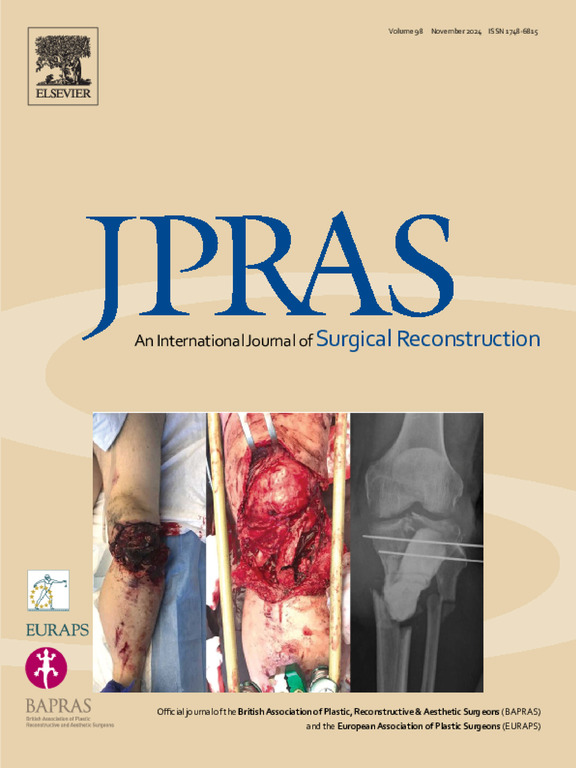Subpectoral to prepectoral pocket change in implant-based breast reconstruction: A retrospective cohort study at a single institution
IF 2.4
3区 医学
Q2 SURGERY
Journal of Plastic Reconstructive and Aesthetic Surgery
Pub Date : 2025-09-16
DOI:10.1016/j.bjps.2025.09.005
引用次数: 0
Abstract
Background
Patients who underwent breast reconstruction with submuscular implants frequently experience animation deformity (AD), pain, and cosmetic issues, warranting consideration of implant removal, exchange, pocket change, or autologous reconstruction. Advances in prepectoral reconstruction have prompted several patients to undergo transfer of their implants from a submuscular to prepectoral pocket (“pocket change”).
Methods
We conducted a single-center, retrospective review analyzing all patients with post-mastectomy submuscular implant-based reconstruction who underwent pocket change procedures from 2014 to 2023.
Results
Procedures on 275 breasts in 153 patients met the inclusion criteria. Reasons for pursuing surgery included pain or discomfort (173 procedures, 63%), AD (158, 57%), non-AD cosmetic issues (92, 33%), muscle spasm (84, 31%), capsular contracture (68, 25%), and implant rupture (44, 16%). In 45 cases (16%), the procedure was staged using prepectoral tissue expanders. Mesh was used in 194 procedures (71%). Mean length of postoperative follow-up was 2.54 years. Complications included 7 seromas (2.5%), 1 hematoma (0.4%), 10 infections (3.6%), and 7 hospitalizations within 30 days of surgery (2.5%). In 6 patients (2.2%), the prepectoral implant was removed within 1 year of surgery—due to 5 infections and 1 capsular contracture. Ten cases (3.6%) of capsular contracture were reported. AD was resolved in all affected patients. Finally, 82 patients reported pain outcomes within 60 days of their unilateral or bilateral procedure, with 75 (91%) experiencing resolved or significantly improved pain.
Conclusions
A pocket change procedure is an effective intervention to treat complications associated with submuscular implant reconstruction. Further study is warranted to evaluate long-term aesthetic and patient satisfaction outcomes.
植体乳房重建术中胸下至胸前口袋变化:一项单一机构的回顾性队列研究。
背景:使用肌下植入物进行乳房重建的患者经常会出现动画畸形(AD)、疼痛和美容问题,需要考虑植入物移除、交换、口袋更换或自体重建。胸前重建技术的进步促使一些患者接受了将植入物从肌下转移到胸前口袋(“口袋改变”)的手术。方法:我们进行了一项单中心回顾性研究,分析了2014年至2023年所有接受乳房切除术后肌肉下植入物重建的患者。结果:153例患者的275个乳房手术符合纳入标准。手术的原因包括疼痛或不适(173例,63%)、AD(158例,57%)、非AD美容问题(92例,33%)、肌肉痉挛(84例,31%)、包膜挛缩(68例,25%)和种植体破裂(44例,16%)。在45例(16%)病例中,手术使用前组织扩张器进行分期。194例(71%)手术使用补片。术后平均随访时间为2.54年。并发症包括7例血肿(2.5%),1例血肿(0.4%),10例感染(3.6%),7例手术30天内住院(2.5%)。在6例(2.2%)患者中,由于5例感染和1例包膜挛缩,在手术1年内切除了乳房前植入物。报告包膜挛缩10例(3.6%)。所有患者的AD均得到缓解。最后,82例患者报告了单侧或双侧手术60天内的疼痛结果,其中75例(91%)疼痛缓解或显着改善。结论:对于肌下假体重建术后并发症的治疗,零钱手术是一种有效的干预措施。需要进一步的研究来评估长期的美学和患者满意度结果。
本文章由计算机程序翻译,如有差异,请以英文原文为准。
求助全文
约1分钟内获得全文
求助全文
来源期刊
CiteScore
3.10
自引率
11.10%
发文量
578
审稿时长
3.5 months
期刊介绍:
JPRAS An International Journal of Surgical Reconstruction is one of the world''s leading international journals, covering all the reconstructive and aesthetic aspects of plastic surgery.
The journal presents the latest surgical procedures with audit and outcome studies of new and established techniques in plastic surgery including: cleft lip and palate and other heads and neck surgery, hand surgery, lower limb trauma, burns, skin cancer, breast surgery and aesthetic surgery.

 求助内容:
求助内容: 应助结果提醒方式:
应助结果提醒方式:


